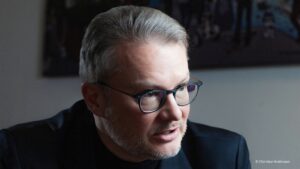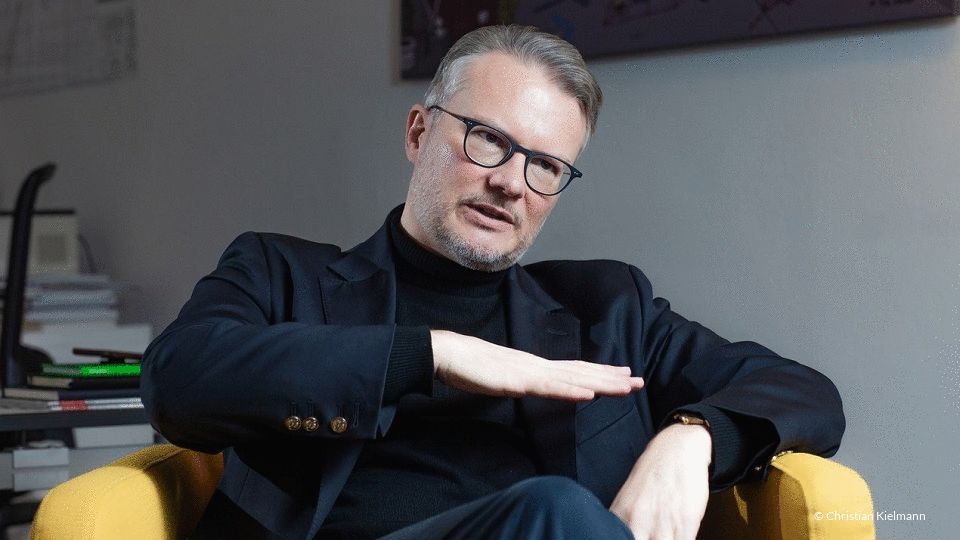As soon as Tegel Airport is closed, a research and industrial park for urban technologies will be created here. In future, students and founders will meet industry and science here to develop new ideas and projects together. In this interview, Prof. Dr. Philipp Bouteiller, Managing Director of Tegel Projekt GmbH, explains the opportunities and possibilities this will create for Berlin.
Mr Bouteiller, Berlin-Tegel Airport is scheduled to close in autumn 2020, as soon as BER goes online. What will happen there then?
Our well-prepared after-use concept for Berlin TXL has three components. First, we are developing a research and industrial park for urban technologies here: the “Urban Tech Republic”. Secondly, the Schumacher Quarter will be built in the eastern part of the site. This will be a completely new neighbourhood on an area of about 50 hectares with more than 5,000 flats for over 10,000 people, a model quarter in terms of sustainability and neighbourhood. Together with our municipal housing associations and other partners, we are working on solutions for the buildings, the traffic and the coexistence of the people in the neighbourhood. Here we want to create affordable living space tailored to new social living conditions. And thirdly, an open landscape space of more than 200 hectares will be created on the northern part of the site. All in all, that is our goal, we want to create a climate-positive piece of the city.
How do you intend to achieve this?
In addition to a whole range of energy efficiency measures and the use of renewable energies, the principle of a drainless residential quarter – we talk about the sponge city principle – plays a major role here. Accumulating rainwater should be kept in the area for as long as possible and only evaporate slowly in order to make the greatest possible contribution to cooling the urban quarter. The water management in the Schumacher Quarter is thus designed for both heavy rainfall and hot spells. Both are phenomena that are likely to become more frequent with climate change.
You see the future “Urban Tech Republic”, the research and industrial park for urban technologies, as the economic heart of your plans. What do you mean by urban technologies?
Urban technologies include all the technical systems, products and services without which our cities would not function. Just think of our plans for the Schumacher Quarter: just like in any other part of the city, we need a reliable energy and water supply there too. We need to take care of the heating and cooling circuits. Waste has to be disposed of and recycled to the greatest possible extent. Waste water must be drained off and then treated again. Building materials are also part of urban technologies. And of crucial importance for any modern city are integrated mobility systems and a modern information and communication infrastructure.
After centuries of urban development, we should be quite well equipped with these urban technologies by now.
The overall quality of life in our European cities has never been as high as it is today. However, this is far from being true to the same extent for all cities in the world. With the Urban Tech Republic, we want to make a contribution to improving urban life in poorer parts of the world as well. Advancing digitalisation offers unimagined opportunities in all areas of urban technologies. In the Urban Tech Republic, we want to research this potential on an area of over 200 hectares, make it usable through concrete applications and ultimately develop solutions and products on an industrial scale. The challenges of our time, especially climate change, urbanisation and demographic change, present us with completely new problems. We can only overcome these with the help of technological and social innovations. This is another reason why Berlin needs the Urban Tech Republic. This opens up a large market for us quite incidentally and thus makes an important contribution to the smart reindustrialisation of the city.

Are there any role models for the project?
So far, there is not a single technology park in the world with a comparable profile. Berlin thus has the chance to take on an absolute pioneering role. The growing importance of urban technologies was already recognised in the preliminary planning for Berlin TXL when most people had never heard of smart cities. That is why we are ahead of other cities in planning today. Thus, as a globally unique research and industrial park with this special profile, the Urban Tech Republic promises to become a strong growth engine for Berlin’s economy. We expect the site to create around 20,000 jobs. Let’s look at Silicon Valley for comparison: many of the start-ups there have attracted other start-ups and lots of venture capitalists. All of these players from science and business are still in a symbiotic, mutually beneficial relationship with each other today. Building a comparable ecosystem with a lot of creative potential is also our goal, even if it requires a lot of staying power: such a development can easily take twenty to thirty years. That’s why we have to create the conditions for it now.
So you want to create a kind of Berlin Silicon Valley with the Urban Tech Republic?
We are planning Berlin’s answer to Silicon Valley. Although the Urban Tech Republic is supposed to function similarly to Silicon Valley in some respects, our model follows a different approach: it is embedded in the tradition of the social market economy. This can be seen in the plans. We want to create a mixture of urbanity and density, of permeability and openness and, above all, enable social diversity. However, one thing is true: you can’t plan everything. The cities we love today are all organically grown structures, but they are based on clever principles of order.
Who do you want to reach with the “Republic” in your name?
It’s about us humans, because technology can take work off our hands, protect us and help us make life more pleasant. But it is always only a means to an end. In this sense, we also understand the “smart city”: A smart city uses the possibilities of digital technologies to sustainably increase the quality of life, the satisfaction and the health of the citizens and at the same time reduce the consumption of resources – which, by the way, also leads to lower consumption costs. If we want to save the world, we have to start in the cities, and it has to be fun, otherwise it won’t work. What are the first steps to making a city or a neighbourhood smart? On a purely technical level, these are initially very simple things, such as a nationwide, fast WLAN, intelligent traffic control, giving priority to walking and cycling while at the same time strengthening public transport, and more supporting sensor technology in public spaces. By the way, there is already a ubiquitous object in the public infrastructure that – if you just rethink it – is perfectly suited for all of this, namely the good old street lamp. If you upgrade it to a charging station with WLAN and various sensors, e.g. for traffic guidance and parking space control, which collects weather and air data, looks good at the same time and also provides light in the end, then we are already right in the middle of the smart infrastructure of tomorrow. Another innovative component for the Schumacher Quarter is the LowEx low-temperature network, which is unique in the world on this scale. We have already planned this in detail. The low-exergy grid can provide heating or cooling as needed by adjusting the grid temperatures. The low temperatures of the network make it possible to use sustainable energy sources such as solar thermal energy, geothermal energy and wastewater heat, which cannot be fed into conventional heating networks because of their low temperature level. The use of renewable energies in the LowEx network can be supplemented by the consumers themselves: by adding energy to the network, for example by feeding in waste heat generated in industry and commerce. In this way, we can supply the Schumacher Quarter with the process heat that is generated in the Urban Tech Republic.
That all sounds highly technical now – is it at all communicable to non-specialists?
For all our technical innovation, we put people at the centre of our planning thinking and actions. And this is also noticeable on the “user interface”. For example, we have developed a mobility concept with a low proportion of motorised private transport – the residential area will be a low-car neighbourhood. We are breaking new ground here, with the connection of the neighbourhood to fast bike paths and the integration of six “mobility hubs”, the neighbourhood garages, with a kiosk and bike shop, bicycle parking spaces and charging stations for electric micro-mobility. The public spaces and green areas are to be used in a variety of ways and co-designed by the residents. A mixed and lively living space also includes lively ground floor zones. To this end, we have developed an innovative concept with diverse, two-storey ground floor typologies for different uses, which allows for retail, day care centres, senior citizens’ meeting places and cafés, and even living, whether as two-storey flats or studios. People must feel comfortable in the new quarters and participate in their own way. Otherwise it will end up being a city frozen in beauty without life.
Prof. Dr Philipp Bouteiller has been responsible for Europe’s largest development project for urban technologies and smart cities as managing director of Tegel Projekt GmbH since 2012. Since 2019, he has also been teaching as part of a professorship for Digital Business and Smart Cities at the Exponential University Potsdam. Philipp Bouteiller holds a degree in communications and first obtained a Master of Science at the London School of Economics and Political Sciences in London, followed by a PhD in international management and social psychology. He lives with his family in Berlin.
